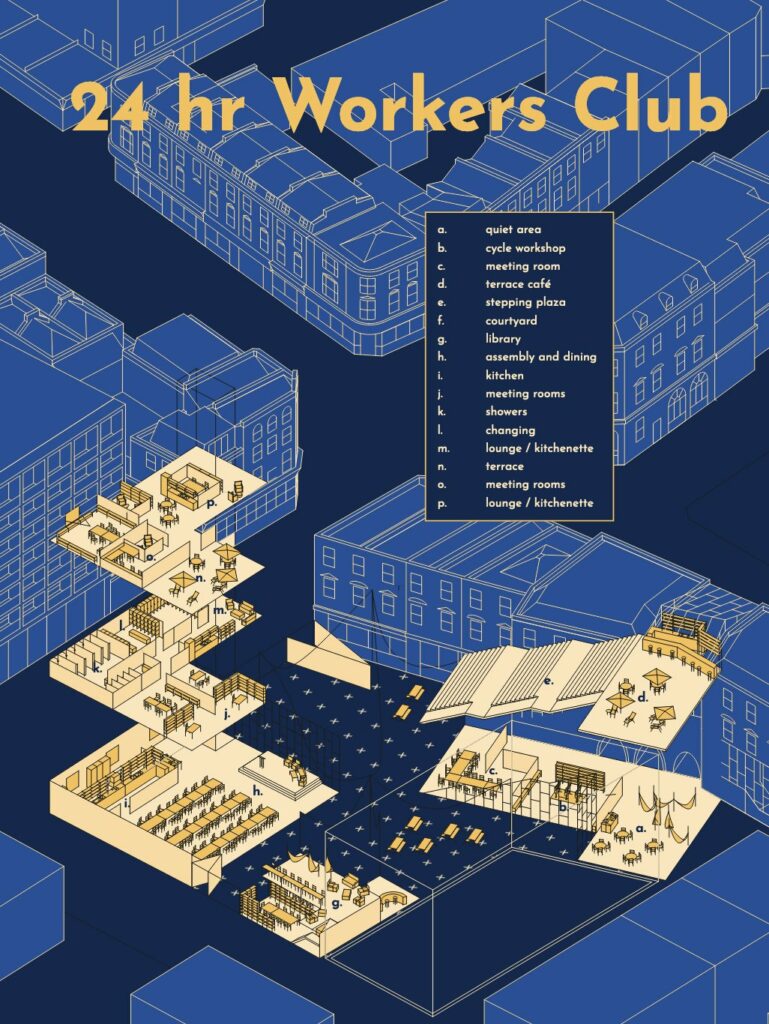Working Nights: municipal strategies for nocturnal workers

The paper ‘Working Nights’ written by Alessio Kolioulis, Julian Siravo, Paul Apostolidis, Camille Kummer-Buléon, Louis Matheou and Cosimo Campani, defines the conditions of four categories of night-time workers.
- Food delivery drivers
- Sex workers
- Domestic care workers
- Night workers in logistics and retail
The paper highlights how cities need to democratise their economies by addressing the inequalities faced by night-time workers.
- Precarity is a defining characteristic of shift and night work. Workers do not choose to work at night, but often only do so out of necessity.
- The rise of precarious night work is partly due to the changing nature of the labour economy. This is particularly true for delivery and care workers.
- Sex work is rarely included in the NTE, but there are an estimated 72,800 sex workers in the UK and working at night is common. It is important to include them in progressive debates about the NTE.
- Workers in logistics, broadly defined as all workers employed in the chain that connects warehouses to retailing, are particularly affected by the precarity-shift work nexus.
- This report considers municipal strategies as a means to democratise the night-time economy, these include policy proposals and foundational infrastructures.
- The report makes two fundamental propositions: it calls for setting up a ‘nocturnal commons’ and argues that a key step to democratise the economy is addressing the precarity of night-time workers.
- Local governments can implement the set of propositions we outline in this part, in collaboration with unions, workers and grassroots organisations.
- The solutions and policies in this report are not intended to encourage more night work: evidence shows the detrimental health effects of shift work on workers.
The paper articulates municipal strategies as a means to democratise the night-time economy. These include policy proposals and foundational infrastructures.
Six suggested policy proposals
1. Establish ‘Night Work Assemblies’
2. Establish a ‘Night Workers Equity Commission’ to advise city-region
3. Apply community-centred frameworks for governing and developing Night Time Economies locally
4. Enforce a ‘Night Time Living Wage’
5. Establish ‘Night Funds’ to leverage resources for Public-Commons-Partnerships
6. Move towards applying community-based frameworks to regulating the night.
The report uses abolitionist frameworks beyond punitive approaches for piloting non-enforcement areas without compromising safety.
The report also calls for setting up ‘nocturnal commons’ infrastructure in the form of 24-hour workers centres, providing services that meet the needs of night-time workers: from trainings to healthcare and from resting stops to spaces for assembly.
Introduce and define the concept of ‘nocturnal commons’:
– Nocturnal commons are built for a community of night-time workers.
– Nocturnal commons are non-commodified common pool resources and services for workers of the night.
– Nocturnal commons are spaces where night-time workers meet, socialise & rest.
– Nocturnal commons improve the wellbeing of night-time workers & their community.
– Nocturnal commons can democratise the night-time economy by sharing resources & leveraging collaborative practices.
Under a Public Common Partnership model for nocturnal commons, local councils could provide the foundational infrastructures workers of the night need to rethink how goods and services are produced and distributed at night. While solutions and policies in the report are not intended to encourage more night work, Alessio argues that local governments can implement the set of propositions in collaboration with unions, workers and grassroots organisations.
Drawing from the direct experience and knowledge of workers, unions, collectives and researchers (too long to tag everyone, check our non non-exhaustive list of references) as well as @VibeLabNetwork and all of the contributors of the Global Night Time Recovery Plan.
